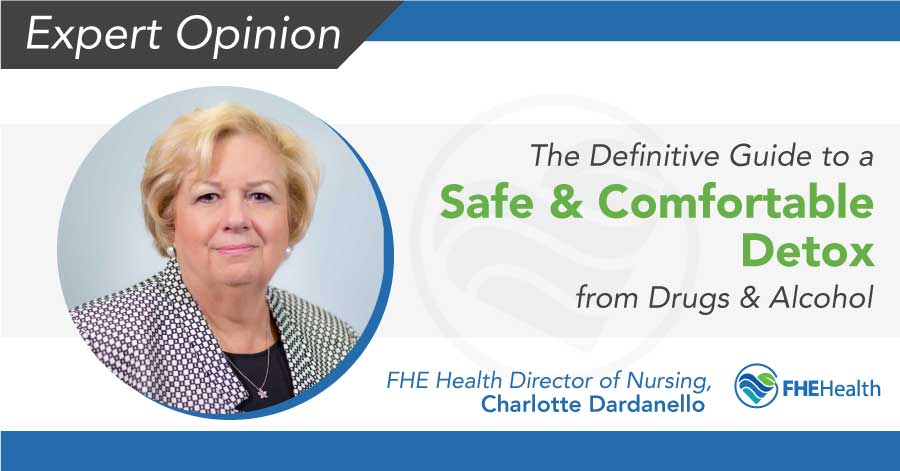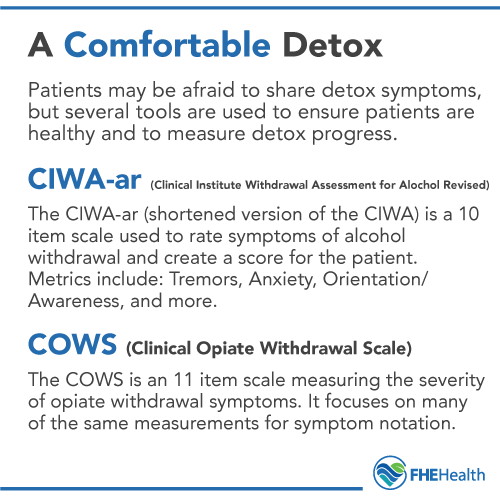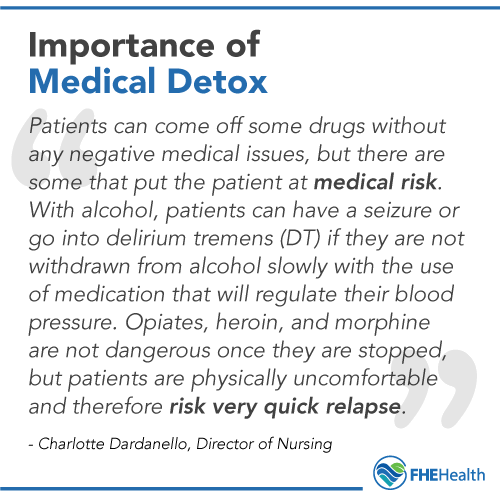
This article has been reviewed for accuracy by our peer review team which includes clinicians and medical professionals. Learn more about our peer review process.
Medically supervised detox is an important and necessary first step towards recovery from drug or alcohol addiction— yet the process, even in an inpatient residential setting, can also be scary for anyone who has become physically and psychologically dependent on one or more substances. One of the more common fears: that withdrawal will be painful and uncomfortable. Read on to get one expert’s guidance that will demystify this and other fears regarding the detox process.
Common Concerns in Detox
 The concern that detox will be painful and uncomfortable is especially common among those “who have been using drugs and/or alcohol to self-medicate painful thoughts and emotions,” Director of Nursing Charlotte Dardanello says. She oversees the nursing care that our detox patients receive. From Dardanello’s experience, “many patients feel afraid that they won’t feel well, because they’ve been self-medicating to obliterate those thoughts.” Naturally, then, the prospect of eliminating a substance which has served as a convenient escape mechanism can be fraught with anxiety and a good deal of emotional pain and discomfort.
The concern that detox will be painful and uncomfortable is especially common among those “who have been using drugs and/or alcohol to self-medicate painful thoughts and emotions,” Director of Nursing Charlotte Dardanello says. She oversees the nursing care that our detox patients receive. From Dardanello’s experience, “many patients feel afraid that they won’t feel well, because they’ve been self-medicating to obliterate those thoughts.” Naturally, then, the prospect of eliminating a substance which has served as a convenient escape mechanism can be fraught with anxiety and a good deal of emotional pain and discomfort.
This isn’t the only fear that Dardanello encounters in detox patients. What can be equally daunting and uncomfortable is the realization that:
- a patient may “not be ready to give up the drug and feels forced into treatment” and anxious about potentially “disappointing their loved one because they’re not 100 percent sure they’re giving [the drug] up.”
- “they have to change their lifestyle, where they go, what they do with their free time, their friends, etc.).”
What Happens in Detox – 24/7 Care from a Multidisciplinary Team of Medical Professionals
Knowing what happens in inpatient detox—especially the intensive level of medical care and clinical support that patients receive in the process—can help to allay such fears. Dardanello shared how a whole multidisciplinary team of medical and clinical professionals, including nurses and nurse practitioners, psychiatrists, doctors, techs, neuro and clinical psychologists, and pharmacists, comes alongside patients during their detox experience. Each of these different professionals has an integral team role to play in ensuring patients’ safety and comfort:
- In conjunction with our medical doctor who conducts a physical exam, our psychiatrist assesses patients upon admission and prescribes medication to relieve withdrawal symptoms and cravings. For example, Valium for alcohol and Suboxone® for opiates are among a number of drugs for detox that our psychiatrist may prescribe.
“A lot of patients have anxiety, so they get meds for anxiety that are non-narcotic,” Dardanello said, adding, “The doctors take very good care to ensure that the patient is not feeling uncomfortable.”
- Our nurses conduct their own detailed assessment of patients upon admission. In addition to administering doctor-prescribed medications and helping patients with medication management, nurses assess physical symptoms and monitor vital signs every four hours, educate patients about the importance of reporting any symptoms they’re experiencing, and run patient education groups.
 Dardanello added that while patients can sometimes be afraid to share what their withdrawal symptoms are, nurses use objective tools to determine exactly what symptoms a patient may be experiencing. “There are screenings done on a daily basis that determine where the patient is and if they are progressing in their detox,” Dardanello said. Specifically, the “CIWA” screening for alcohol withdrawal and the “COWS” for opiate withdrawal help to identify what symptoms a patient may be experiencing and where they are in their withdrawal (what phase).
Dardanello added that while patients can sometimes be afraid to share what their withdrawal symptoms are, nurses use objective tools to determine exactly what symptoms a patient may be experiencing. “There are screenings done on a daily basis that determine where the patient is and if they are progressing in their detox,” Dardanello said. Specifically, the “CIWA” screening for alcohol withdrawal and the “COWS” for opiate withdrawal help to identify what symptoms a patient may be experiencing and where they are in their withdrawal (what phase).
- Techs also closely monitor patients’ safety and comfort, with 15-minute checks around the clock; and they run community meetings and goals groups, where patients have an opportunity to get help and feedback regarding any physical or emotional issues that may be causing them concern or distress. Besides assisting our nurses with the 24/7 monitoring of vital signs, techs transport patients to any off-site medical appointments.
- Our pharmacists at FHE Health’s on-site pharmacy make meds available for patients, fill physician orders, provide patient consultations regarding medication(s) as needed, and help to oversee the safety of the medication process.
- Lab techs carry out on-site lab testing of blood and urine, giving IV fluids when patients (who often arrive dehydrated and in poor condition) need them.
- Meanwhile, our clinicians and case coordinator lead group and individual therapy sessions. These address the psychological and emotional explanations for why patients have been self-medicating their pain, and help patients to develop healthy, alternative coping skills and recovery tools for managing difficult thoughts, emotions and issues associated with them.
- Our neuro team provides another unique and important aspect of the therapeutic experience at FHE Health, using Neuro Rehab to alleviate common withdrawal symptoms like anxiety, depression insomnia, and restoring brain health and balance in the aftermath of addiction.
Steps in the Detox Process – What to Expect
In addition to having the close 24/7 medical supervision of a whole team of experienced medical professionals, patients who come to FHE Health for drug or alcohol detox can expect to follow an established treatment protocol that best supports a safe and complete detox that is as comfortable as possible. Here are the steps that comprise that protocol, following a patient’s intake:
- Step 1 – Nursing assessment: Patients first receive a full nursing assessment that includes questions about their work and living situation, support system, legal issues, and other co-occurring issues, such as gambling issues or an eating disorder.
- Step 2 – Psychiatric and medical assessment: After an in-depth nursing assessment, patients meet with our psychiatrist and medical doctor to get a detailed psychiatric assessment and full history and physical.
- Step 3 – Medications for symptom management: Patients embark on their medical plan of treatment, which may involve receiving drugs that assist with detox.
- Step 4 – Rest and sleep: Dardanello says patients “are often exhausted when they come in from long periods of use and no sleep,” so catching up on rest is an important part of the healing process.
- Step 5 – Healthy eating, fruits, vegetables, full meals: Similarly, most patients arrive malnourished, having not been eating well or nutritiously prior to admission, according to Dardanello. Another goal during detox, then, is to begin eating well-balanced meals three times a day, so that patients are rebuilding their immune system with healthy nutrition.
- Step 6 – Group therapy: Dardanello said this consists of “a few groups a day— not anything heavy emotionally, as patients are still not thinking clearly.” Still, patients can begin to process the painful thoughts, emotions and issues that they have been self-medicating, and learn tools for overcoming these addiction triggers.
- Step 7 – Individual meetings with a case coordinator and therapist: In these sessions, patients can further process the negative aspects of an addiction and losses that have occurred during their use, and get individualized attention regarding their therapeutic needs.
Why Medically Supervised Detox – and the Dangers of Home Remedies for Detox
Medically supervised detox is the gold standard of care for people with substance addictions. That’s because detoxing on one’s own using home remedies for detox—without the care of medical experts—puts you at risk of unforeseen medical complications, such as seizures, and a greater likelihood of relapsing, according to Dardanello. Here is how she explained the importance of medically supervised detox:
“Patients can come off some drugs without any negative medical issues, but there are some that put the patient at medical risk. With alcohol, patients can have a seizure or go into delirium tremens (DT) if they are not withdrawn from alcohol slowly with the use of medication that will regulate their blood pressure. Opiates, heroin, and morphine are not dangerous once they are stopped, but patients are physically uncomfortable and therefore risk very quick relapse.”
How Long Is Detox and What to Know Re: Rapid Opiate Detox
 Length of detox can depend on the drug(s) and individual factors like the severity of an addiction, your medical history, and the presence of any co-occurring mental health issues. Alcohol detox can be five to 10 days. Opiate detox can be five to seven days.
Length of detox can depend on the drug(s) and individual factors like the severity of an addiction, your medical history, and the presence of any co-occurring mental health issues. Alcohol detox can be five to 10 days. Opiate detox can be five to seven days.
With opiates, some facilities advertise that they provide “rapid opiate detox.” The process involves administering the oral opioid antagonist drug naltrexone along with oral or intravenous sedating meds. With “ultra-rapid opiate detox,” patients purportedly receive general anesthesia with intravenously administered naltrexone.
These expedited withdrawals can be tempting. (Who doesn’t want to get detox over with as soon as possible— especially when withdrawal symptoms for opiates can be so uncomfortable?) What many people don’t know, however, is that rapid detox presents certain dangers. These have been laid out in a report by the American Society of Addiction Medicine:
- Detox alone is not sufficient treatment for opiate addiction.
- Ultra-rapid opiate detox is a procedure “with uncertain risks and benefits, and its use in clinical settings is not supportable until a clearly positive risk-benefit relationship can be demonstrated.” Similarly, further research is needed regarding rapid opiate detox.
For these reasons, FHE Health does not offer rapid opiate detox or ultra-rapid detox. Dardanello has her own opinion about why the procedure is not sufficient in treating opiate addiction and can pose risks for addiction patients. She thinks patients need more time and presence of mind— (without the heavy sedation of a rapid detox)—to begin to process the complex issues that landed them in rehab. That’s where true recovery can begin.






